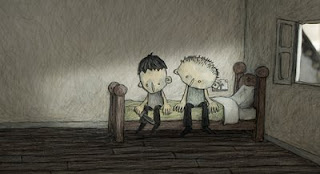I'm a Jew... I'm small... I'm homosexual... and I live in Sheffield. I'm fucked.
How do I define history? Well it's just one fucking thing after another.
[about A.E. Housman]
Timms: Wasn't he a nancy, sir?
Hector: Foul, festering, grubby-minded little trollop! Do not use that word!
[Hits him on the head with an exercise book]
Timms: But you use it, sir!
Hector: I do, sir, I know, but I am far gone in age and decrepitude.
[talking about the Holocaust]
Posner: But to put something in context is a step towards saying it can be understood and that it can be explained. And if it can be explained that it can be explained away.
Can you, for a moment, imagine how depressing it is to teach five centuries of masculine ineptitude?
Timms: I don't always understand poetry!
Hector: You don't always understand it? Timms, I never understand it. But learn it now, know it now and you'll understand it... whenever.
The more you read, though, the more you'll see that literature is actually about losers. It's consolation. All literature is consolation.
Fuck the Ren-ai-ssance! And fuck literature, and Plato, and Michaelangelo, and Oscar Wilde, and all the other shrunken violets you people line up. This is a school, and it isn't normal!
How do I define history? Well it's just one fucking thing after another.
[about A.E. Housman]
Timms: Wasn't he a nancy, sir?
Hector: Foul, festering, grubby-minded little trollop! Do not use that word!
[Hits him on the head with an exercise book]
Timms: But you use it, sir!
Hector: I do, sir, I know, but I am far gone in age and decrepitude.
[talking about the Holocaust]
Posner: But to put something in context is a step towards saying it can be understood and that it can be explained. And if it can be explained that it can be explained away.
Can you, for a moment, imagine how depressing it is to teach five centuries of masculine ineptitude?
Timms: I don't always understand poetry!
Hector: You don't always understand it? Timms, I never understand it. But learn it now, know it now and you'll understand it... whenever.
The more you read, though, the more you'll see that literature is actually about losers. It's consolation. All literature is consolation.
Fuck the Ren-ai-ssance! And fuck literature, and Plato, and Michaelangelo, and Oscar Wilde, and all the other shrunken violets you people line up. This is a school, and it isn't normal!







 What we know as direct cinema has been around for over 40 years. Given the esteem in which story is held today and the lack of esteem for conceptual effort, one would imagine that this would be the predominant form of portrayal. In "To Be and to Have" (Être et avoir) Philibert did succeed in making a documentary which was direct cinema but he remains the exception. A documentary which chooses to use purely narrative form is necessarily direct. Free from commentary or any other literal explanation, a film of this kind seeks to avoid disintegrating into good or bad generalities.
What we know as direct cinema has been around for over 40 years. Given the esteem in which story is held today and the lack of esteem for conceptual effort, one would imagine that this would be the predominant form of portrayal. In "To Be and to Have" (Être et avoir) Philibert did succeed in making a documentary which was direct cinema but he remains the exception. A documentary which chooses to use purely narrative form is necessarily direct. Free from commentary or any other literal explanation, a film of this kind seeks to avoid disintegrating into good or bad generalities.